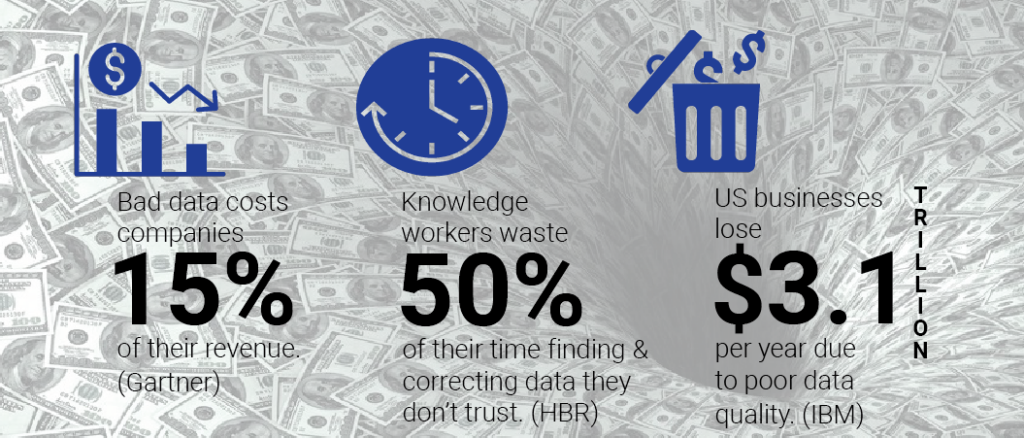4 Reasons Why Bad Data is Bad for Business
We all know that the best decisions made—especially in business—are those based on accurate information. With so much at stake, it’s hard to justify your ‘gut instinct’ to the boss.
- You know you need data.
- You know you need accurate data.
- And you know you need that accurate data accessible.
But how do you get there?
Sure, you have data. You’ve saved all your past estimates. You have Excel spreadsheets of costs. It’s scattered here. It’s scattered there. Retrieval is a headache.
We hear all the time from precon managers they know how important big data is but what they don’t know is the first step in organizing and utilizing all that data. With it saved here, saved there, saved everywhere…it’s extremely difficult to mine all that data, much less analyze it. How much time do you spend wrangling data? More importantly, do you trust that data?
This is an understatement but, a lot is riding on the line here.
It may seem intuitive but first, let’s define what “big data” is.
What is Big Data?
Big data refers to very large sets of data that require management systems to store, maintain, and recall so it can be analyzed and utilized properly.
IBM breaks down big data to volume-how much, velocity-the rate the data is created, and variety-all the different types of data.
The term ‘big data’ in the way we know it now was first coined by a guy named Roger Mougalas in 2005. He defined it as data so large it was impossible to contain and process. Fortunately, there are now solutions to that problem…but more about that later.
It’s kind of Matrix-y but big data is swirling all around us, gathering our information anytime we log into apps on our phone, email, and the internet. Data is constantly being collected. In 2016, 5 exabytes (EXABYTES) of data were being stored every two days. Imagine what that number is today…
What is an Exabyte?
Okay, so an exabyte is really, really REALLY big! Storage cloud company Backblaze writes, “1 exabyte (EB) = 1018bytes = 1,0006bytes = 1000000000000000000 bytes = 1,000 petabytes = 1 million terabytes = 1 billion gigabytes.” Simpler put: “1 Exabyte equals 1 trillion Megabytes.” In other words, that’s a crap ton of data.
Anyway, back to data…
Now, just because you have data doesn’t make it correct data. For example, you enter numbers in your spreadsheet according to what a subcontractor tells you. Or you copy and paste from an old estimate. But that old number you copied might not be right anymore—especially if it is material costs—or you accidentally missed a zero when entering in the cost of labor. Your computer program doesn’t know those numbers are wrong. It just processes what you told it. However, these types of mistakes will rear their ugly heads when your estimate turns out wrong and you lose the bid.
What we’re getting to here is that bad data is bad for business. And the cost of bad data can be catastrophic—to the tune of up to $15 million a year. Whoa.
How Bad Data Hurts Your Business
“Bad data has the horrifying potential to allow your company to do the wrong thing with the full assurance that it is making the right choice.” - Threedollarclick.net
Bad data is any data this is inaccurate, wrong, or incomplete.
Bad data:
- Creates mistakes that cost you money
- Delays or prevents sound decision making
- Develops mistrust with owners
- Results in poor performance and inefficient processes
Creates Mistakes That Cost You Money
Autodesk reports that $31.3 billion of rework is caused by poor project data and miscommunication. When your data sources are spread through different resources, the likelihood of being able to piece the complete puzzle together falls significantly.
Without reassurance that you’ve gathered all the information available, how can you be sure your estimate is correct and complete? With the statistic that 98% of all large projects go over budget, we feel confident in saying, that ‘yes, indeed, inaccurate and incomplete data does cost your company money.’
Delays or Prevents Sound Decision Making
Errors in your data create errors in your estimate. When data is incomplete or wrong, estimators can’t present solutions to problems. Time spent tracking down the right information is time another contractor could be completing their estimate and preparing for bid day. All the while you look unorganized (because you are) and unprofessional.
Develops Mistrust with Owners
Change-orders. Over budget. These things not only cost you money but also cost you your reputation. If you provide bad data to your owners and stakeholders—no one can make the right decisions. Owners who get the wrong information and feel like you’ve given them an inaccurate estimate won’t pick your bid and certainly won’t repeat their business with you.
Results in Poor Performance and Inefficient Processes
When your team is frantically wrangling data from different sources, you can’t trust how much that data has changed from where it originated—if you can find that—to what you need now. As illustrated above, bad data creates bad estimates. Frustrated estimators that make mistakes at no fault of their own will eventually leave your company for one in which more efficient processes are in place. Project management tool, Wrike, found that 18% of 23 to 38 years old’s quit jobs due to inefficient work processes. With a shortage of estimators in the industry, you can’t afford to lose your best workers.
How to Leverage Your Data
“The goal is to turn data into information, and information into insight.” – Carly Fiorina
We’ve established how important accurate data is and hopefully, you’re on board to become a data-driven preconstruction team. Good data will help increase efficiency, save your team time, and produce better estimates. Take these three steps to better leverage your data.
- Standardize one centralized location where all information is stored.
- Choose a solution that integrates with your other essential software. (One of the biggest culprits of bad data is the use of multi-platforms that don’t integrate, causing data to be lost and outdated.)
- Use historical costs to analyze past projects to help plan for the future.
It’s not just that you have the right data, you need to use it. Beck Technology’s DESTINI Estimator construction estimating software will help you mine your data properly for you to make better-informed decisions and win bids.
With Estimator you can:
- Find past mistakes and correct them
- Perform 2D and 3D takeoff
- View historical cost data
- Compare current estimates to past estimates
- Create endless sorting fields
- Replace Excel, Timberline Sage, WinEst, and MC2
- Integrate Procore drawings and documents, Autodesk, Construct Connect, Join, and PowerBI
- Create comprehensive reports for customers
Here are 3 ways you can improve the accuracy your construction data.
Let us help you eliminate bad data from your equation and begin a streamlined, accurate process that wins projects. Reach out to us today and request a free demo by clicking the button below.

-1.png?width=112&height=112&name=image%20(4)-1.png)
















